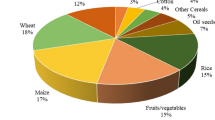Abstract
Agricultural activities are important contributors to the emissions of greenhouse gases. This study ascertained the dynamic emission of nitrous oxide (N2O) from a paddy field under a rice-duck farming system in South China. Two different cultivation and fertilizer treatments, namely, organic fertilizer + ducks (OF+D) and chemical fertilizer + ducks (CF+D) treatments, were employed in this study. Experimental data showed that diurnal variations of N2O emission were highly correlated with the activities of ducklings. The rates of N2O emission were normally increased in the early morning and late afternoon due to the frequent movement of ducklings at these time periods. Our study further revealed that the rates of N2O emission from the paddy field varied with the types of fertilizers used as well as with the stages of the rice growth. In general, the rates of N2O emission were higher for the CF+D treatment than for the OF+D treatment, whereas more N2O was emitted from the paddy field at the tillering stage than at the heading stage. The global warming potential with the use of the organic fertilizer was about 22% lower than with the use of the chemical fertilizer.





Similar content being viewed by others
References
Brady NC (1984) The nature and properties of soils. 9th ed. Macmillian, New York
CMDL (2002) Climate monitoring and diagnostic laboratory (CMDL) of the national oceanographic and atmospheric administration, Boulder, CO ( N2O data available at: http://www.ftp.cmdl.noaa.gov/hats/n2o/insituGcs/global/)
Grosso SJD, Parton WJ, Mosier AR, Walsh MK, Ojima DS, Thornton PE (2006) DAYCENT national-scale simulations of nitrous oxide emissions from cropped soils in the United States. J Environ Qual 35:1451–1460
Huang Y, Wang H, Huang H, Feng ZW, Yang ZH, Luo YC (2005) Characteristics of methane emission from wetland rice–duck complex ecosystem. Agr Ecosyst Environ 105:181–193
IPCC (Intergovernmental Panel on Climate Change) (2001) Intergovernmental panel on climate change technical summary of the 3rd assessment report of working group 1. IPCC, Geneva
Khalil MAK, Shearer MH (2006) Decreasing emissions of methane from rice agriculture. Int Congress Ser 1293:33– 41
Kumaraswamy S, Rath AK, Ramakrishnan B, Sethunathan N (2000) Wetland rice soils as sources and sinks of methane: a review and prospects for research. Biol Fertil Soils 31:449–461
Malla G, Bhatia A, Pathak H, Prasad S, Jain N, Singh J (2005) Mitigating nitrous oxide and methane emissions from soil in rice–wheat system of the Indo-Gangetic plain with nitrification and urease inhibitors. Chemosphere 58:141–147
Mishra S, Rath AK, Adhya TK, Rao VR (1997) Effect of continuous and alternate water regimes on methane efflux from rice under greenhouse conditions. Biol Fert Soils 24:399–405
Mosier A, Kroeze C (2000) Potential impact on the global atmospheric N 20 budget of the increased nitrogen input required to meet future global food demands. Chemosph Global Change Sci 2:465–474
Rolston DE (1986) Gas flux. In: Klute A (ed) Methods of soil analysis. 2nd ed. Agronomy Monograph No. 9. ASA and SSSA, Madison, WI, pp 1103–1119
Sass RL, Fisher FM, Lewis ST, Jund MF, Turner FT (1994) Methane emission from rice fields: effects of soil properties. Global Biogeochem Cyc 8:135–140
Wang Y (2000) Studies on ecological benefits of planting and breeding model in rice fields. Acta Ecol Sinica 20:311–316
Wang Y, Wang Y (2003) Quick measurement of CH4, CO2 and N2O emission from a short-plant ecosystem. Adv Atmos Sci 20:842–844
Watson RT, Zinyowera MC, Moss RH, Dokken DJ (1996) Climate change1995, impacts, adaptations and mitigation of climate change: scientific–technical analyses. Intergovernmental Panel on Climate Change. Cambridge University Press, New York
Yang SS, Lin CC, Chang EH, Chang RS, Hung SN (1994) Effect of fertilizer, soil type, growth season on methane production and emission in the paddy soils of Taiwan. J Biomass Energy Soc China 13:68–87
Yang SS, Liu CM, Lai CM, Liu YL (2003) Estimation of methane and nitrous oxide emission from paddy fields and uplands during 1990-200 in Taiwan. Chemosphere 52:1295–1305
Zheng YH, Deng GB, Lu GM (1997) Eco-economic benefits of rice–fish–duck complex ecosystem. J Appl Ecol 8:431–434
Acknowledgments
This study was supported by the National Basic Research Program of China (973 Program; 2006CB100206), Guangdong Key Research Program (2004B20101017), China, and Guangdong Natural Science Foundation (06105467), China.
Author information
Authors and Affiliations
Corresponding author
Rights and permissions
About this article
Cite this article
Zhang, JE., Ouyang, Y. & Huang, ZX. Characterization of Nitrous Oxide Emission from a Rice-Duck Farming System in South China. Arch Environ Contam Toxicol 54, 167–172 (2008). https://doi.org/10.1007/s00244-007-9014-4
Received:
Accepted:
Published:
Issue Date:
DOI: https://doi.org/10.1007/s00244-007-9014-4




